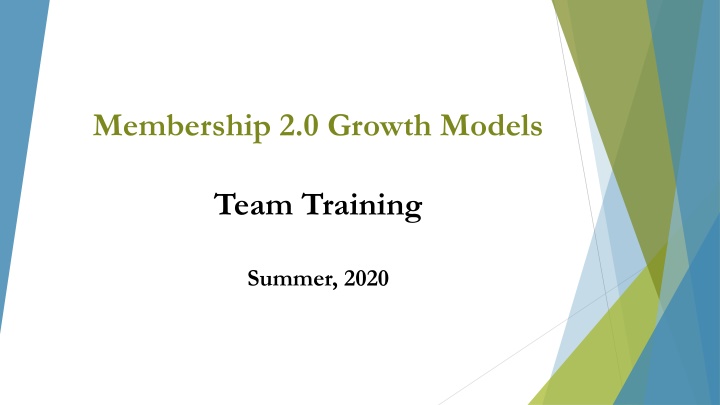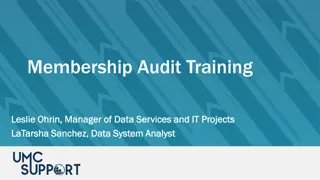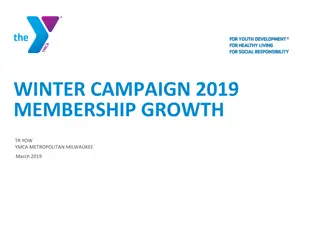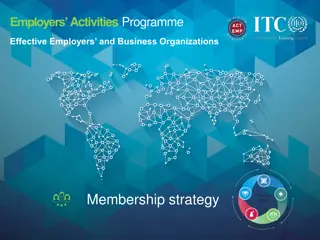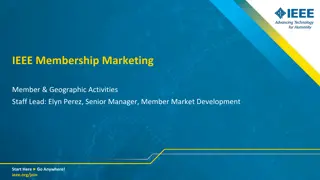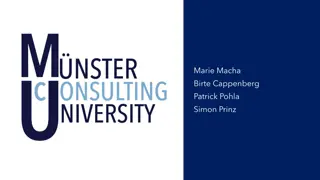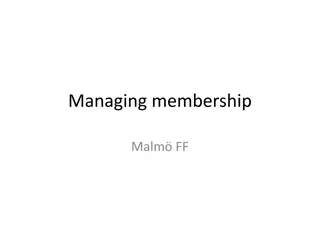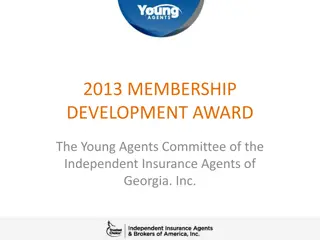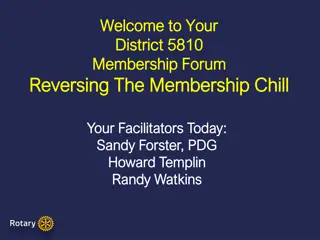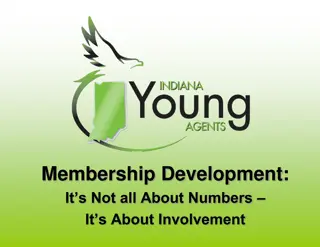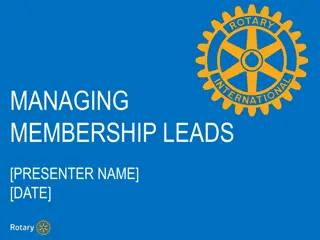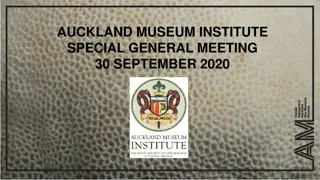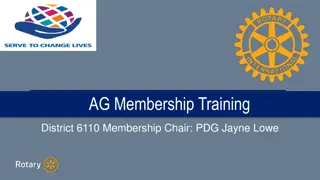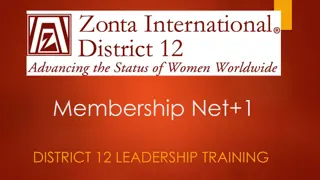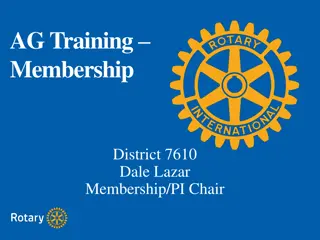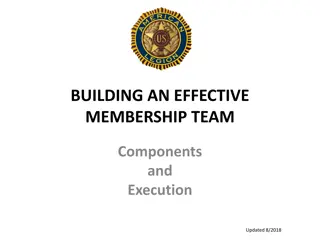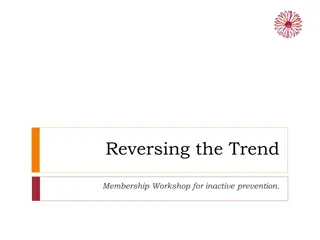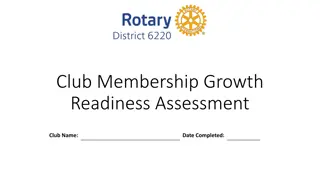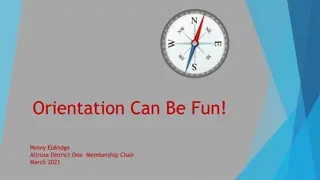Altrusa International Membership Growth Strategy Summer 2020
Altrusa International's Membership 2.0 Growth Models Team Training for Summer 2020 focused on enhancing membership diversity, targeting untapped markets, educating members on Altrusa's tenets, and providing support for under-charter clubs. The committee identified three growth models: DISCOVERY, POWER, and LEARNING, each designed to help clubs in different ways. New teams were formed to implement these models, led by dedicated individuals. Additionally, resource teams were established to ensure consistency and avoid duplication in presentations.
Download Presentation

Please find below an Image/Link to download the presentation.
The content on the website is provided AS IS for your information and personal use only. It may not be sold, licensed, or shared on other websites without obtaining consent from the author.If you encounter any issues during the download, it is possible that the publisher has removed the file from their server.
You are allowed to download the files provided on this website for personal or commercial use, subject to the condition that they are used lawfully. All files are the property of their respective owners.
The content on the website is provided AS IS for your information and personal use only. It may not be sold, licensed, or shared on other websites without obtaining consent from the author.
E N D
Presentation Transcript
Membership 2.0 Growth Models Team Training Summer, 2020
Membership goals from the District Nine strategic plan: 1. Actively recruit, retain and embrace a diverse membership. 2. Focus on untapped markets of potential members, including ASTRA parents and representatives from organizations we serve. 3. Educate members on the basic tenets and policies/procedures of Altrusa so they are more engaged. 4. Provide targeted support for under-charter clubs in identified areas of weakness.
Membership 2.0 committee: Membership 2.0 was tasked with drilling down on each of these goals and identifying clear and direct paths for clubs to actualize growth through achieving these goals.
The outcome of the 12 week discussion was three growth models DISCOVERY POWER LEARNING 4
Membership 2.0 Growth Models DISCOVERY Model designed to help clubs seek new prospective members in untapped markets for a more diverse club membership as they discoverwho they are missing and where they haven t been looking. POWER Model designed to fast-track clubs needing to rebound from a membership setback through new approaches to growth, clubs experience a power surge with their rebound LEARNING model will help members learn about Altrusa to make them more engaged 5
Next Step to Implement the Growth Models New Teams formed for each model: DISCOVERY led by Sharon Tramonte Altrusa International of San Antonio POWER led by Stacy Earls Altrusa International of Greenville LEARNING led by Debbie Mabry Altrusa International of Temple 6
Additionally, two resource teams formed to help model teams Everything coming out of the teams should have the same basic appearance and follow branding protocols to make sure there is continuity in presentation. We also want to avoid duplication between the model teams and with International. Tools Team Wendy Santiago, team leader Will work on any print or collateral materials requested by the three Model Teams. Technology Team Holly McCoy, team leader Will assist the Model Teams with ideas that require social media/technology, videography, photography, electronic meetings and other forms of online c communication. 7
The DISCOVERY Team Diversifying membership and focusing on untapped markets Sharon Tramonte, San Antonio, Team Leader Betty Sainz, Garland Michelle DiGaetano, Temple Charmaine Wynter, DFW Sherry Patterson, Waco Versie Lusk, SWDC .
DISCOVERY Model Team Goals 1. Use the model to help clubs think outside the box and get excited about the prospects for significant growth. 2. To encourage and assist clubs to pursue ideas to find new potential members that fit their club . 3. Develop ways to assist clubs in engaging new members using the ideas on the report
DISCOVERY Model Where to find potential new members 1. Digital environment Entrepreneur networks, e.g., Roam Innovative Workplace Online networking groups Social media platforms 2. Professional environment Corporations who sponsor service projects with their employees as volunteers Small businesses Job placement services Chamber of Commerce, local Economic Development Corp. Altrusans places of employment and those of their family members
DISCOVERY Model Where to find potential new members 3. Academic environment High schools (including student volunteer and parent volunteer organizations) Colleges/Universities/Graduate programs Trade/Vocational schools, Career counseling offices Job fairs 4. Social environment Community organizations and events: newcomer groups, leadership development programs, service groups, fairs, festivals Families: neighborhood groups, book clubs, athletic leagues, Altrusans family members Non-profit organizations: Altrusa beneficiaries, recently formed and in need of assistance, established with broad community support Faith-based groups: places of worship, study groups, community outreach ministries Military support groups: auxiliaries for families of active duty military, veterans groups
DISCOVERY Model How to engage potential new members 1. General 2. Professionals 3. Student/Parent Volunteers - College students - Vocational/Trade School students - High School 4. Community Groups - Military - Community leadership programs (e.g., Leadership Dallas) - Newcomers to the community - Nonprofit volunteers - Communities where Altrusa is currently unserved or underserved
DISCOVERY Model What s in it for them? Offer prospective members a benefit statement Altrusa offers a networking opportunity Altrusa offers an opportunity to be a trailblazer for change in our communities Altrusa helps families and friends. Altrusa provides meaningful and fulfilling work and through this work, opportunities for leadership development. Members can acquire and
The POWER Team Understanding the setback to make a comeback Stacy Earls, Greenville, Team Leader Wendy Santiago, Lake Cities Tina Hampton, SETCER Sheila Winton, Pampa Kim Glodich, San Antonio Melanie Harrell, Central Texas Stephanie Noland, Garland .
POWER Model Team Goals 1. Design a tool or method to help clubs assess their setbacks. 2. Identify different ways clubs to approach clubs needing to go through the setback/comeback discussion . 3. Work with a club identified as needing assistance using the model s setback/comeback information. 4. Ongoing support - explore ways District leadership can assist with keeping a club motivated and strong.
POWER Model UNDERSTANDING THE SETBACK Clubs need to HONESTLY identify possible causes for a loss of members: 1. Personnel or people issues: Someone wanting to be the boss who is not qualified; backstabbing; someone being promoted who did not deserve it; conflict/internal division 2. Not enough successes to keep members excited and going strong 3. Poor leadership: Not handling business correctly; not following the rules 4. Lack of engagement/involvement/ investment: Joining Altrusa for the wrong reasons
POWER Model UNDERSTANDING THE SETBACK 5. Financial requirements too stressful on a budget 6. Life! Too busy at home, with family responsibilities, at work 7. Membership aging, death, disability, loss of mobility 8. No connection with social media-based members (especially the 25- to 35-year-olds) 9. Reliance on one or just a few members who then move on 10. Burn-out in leadership
POWER Model Making a Comeback Once the causes for the setback are identified, clubs should concentrate on making a comeback with a strategy that avoids those causes: 1. Concentrate on community service rather than meetings 2. Get to know the members as friends and avoid potential conflict 3. Grow the leadership to allow ALL members to experience success 4. Focus on the brand drivers of clarity, flexibility, inclusiveness 5. More activities within the community 6. Provide encouragement (District) 7. Sales pitches (describe why Altrusa is important) 8. Identify why your club began to shrink in the first place 9.Focused recruitment .
The LEARNING Team Engaging members by educating members Debbie Mabry, Temple, Team Leader Holly McCoy, Austin Betty Lawson, Dallas Linda Moore, Temple Shawna Elliott, Pampa Kasey Smith, Greenville Kathy Folley, Temple .
LEARNING MODEL Increasing member buy-in through understanding Altrusa structure, processes and rich traditions. Part One: Critical Content Top 12 topics that the M2.0 team thought were critical for both new and more seasoned members to understand about Altrusa. Part Two: Delivery Options Key ways to deliver the information to our members GOAL: Discuss each content item, one at a time, decide what information needs to be communicated to Altrusans and then HOW to deliver it. 20
LEARNING MODEL Critical Content 1. Inclusivity 2. Understand financial requirements 3. Multi-layered 4. Fellowship 5. Understand club bylaws and policies 6. Community service and community development 7. Altrusa Principles 8. Connectivity 9. Strategic Planning 10. Officers and Directors 11. Protocol 12. Teamwork. 21
LEARNING MODEL Increasing member buy-in through understanding Altrusa structure, processes and rich traditions. After each critical content item is discussed by the team and consensus is reached on what should be shared, the team will go through possible delivery options and decide which one(s) would be best to use . 22
LEARNING MODEL DELIVERY OPTIONS FOR GETTING INFORMATION TO MEMBERS: 1. New member orientations 2. Monthly Accents - 3. District webinar training via online platform 4. Videos presentations - 5. Monthly club in-service. 6. Games 7. New member inclusion 8. Altrusa Key 9. Banner/Sign 10. Social media 11. Show-and-tell at District Conference 12. Messaging app 13. Traveling Trainers 14. Getting to know you 23
Things to remember. - Participation in Membership 2.0 by the clubs will be optional - This is a new approach! There is no right or wrong way to use the models. Think outside the box! - there is a step three to this done Working 24
The future belongs to those who believe in the beauty of their dreams. Eleanor Roosevelt, Altrusa Club of New York City 25
